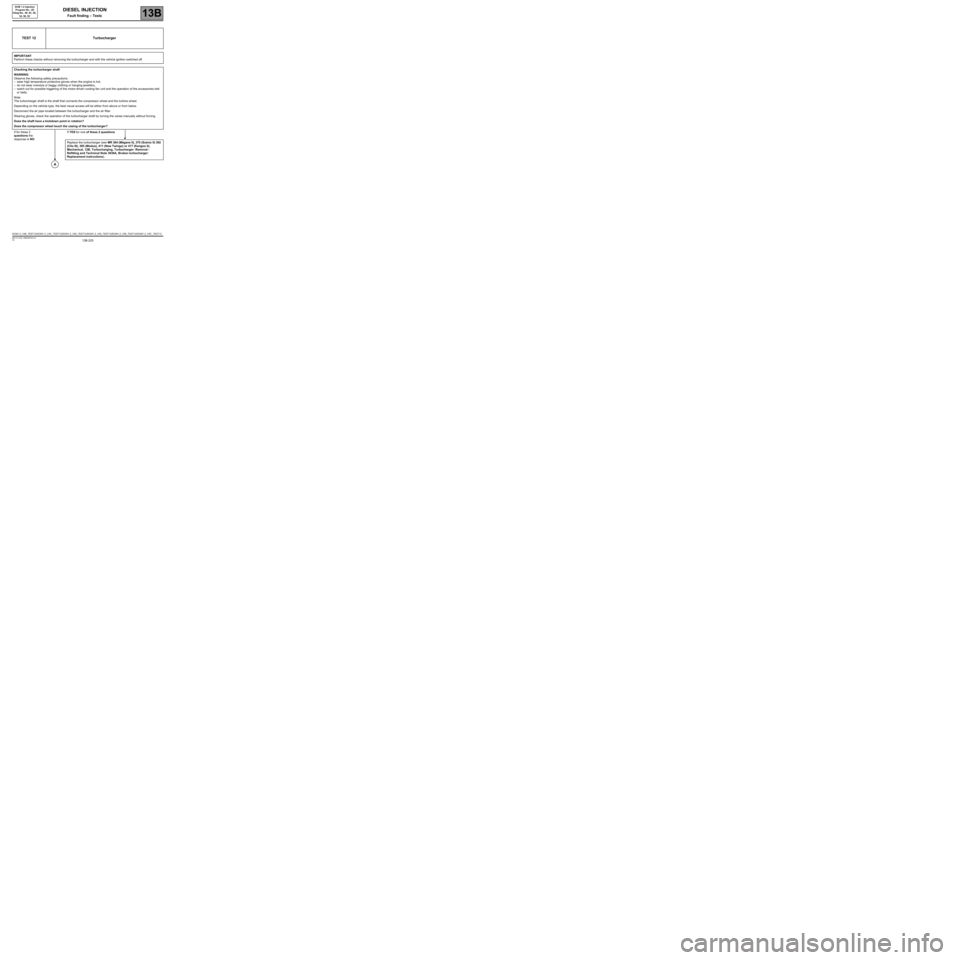Page 200 of 269

13B-200
AFTER REPAIRDeal with any faults displayed by the diagnostic tool. Clear the computer fault
memory.
Carry out a road test followed by another check with the diagnostic tool.
V6 MR-413-X44-13B000$170.mif
DIESEL INJECTION
Fault finding – Interpretation of parameters13B
DCM 1.2 Injection
Program No.: 4D
Vdiag No.: 54, 5C
PR873OIL OXIDATION SIGNAL
PARAMETER
DEFINITIONThis parameter indicates the vehicle distance in km when the warning requesting the
oil change was displayed on the instrument panel.
NOTESThis parameter is not to be interpreted:
–on the K9K812 engine,
–if PR873 = 0 (Vdiag 58 only).
Conformity check: Engine stopped, ignition on or engine running.
The oil status is calculated by the oxidation program in the injection computer, depending on the engine revs.
When this count reaches a certain threshold before the end of the oil change period, the injection computer sends
a signal to the instrument panel, which will display "service required soon". PR873 corresponds to the vehicle
distance at the time this signal is sent.
The instrument panel computer will then count 900 miles (1500 km) before displaying the message "service
required".
IMPORTANT
When the message Service required appears on the instrument panel, the customer must arrange an oil change
within the remaining 900 miles (1500 km).
DCM1.2_V54_PR873/DCM1.2_V5C_PR873
Page 212 of 269

13B-212V6 MR-413-X44-13B000$190.mif
DIESEL INJECTION
Fault finding – Tests13B
DCM 1.2 Injection
Program No.: 4D
Vdiag No.: 48, 4C, 50,
54, 58, 5C
TEST 6 High pressure system check
NOTESSpecial note:
Certain faults make it impossible to carry out this test - deal with these first.
WARNING
Running the starter motor for more than 5 seconds is dangerous and serves no
useful purpose.
Preliminary checks:
–Check for the presence of fuel
–Check that there is no air in the low pressure circuit. Run TEST 1 Low pressure circuit check.
–Ensure that the correct fuel is being used. Run test 13 Diesel fuel conformity check.
The pump's capacity to produce high pressure can be checked by the following procedure:
–With the ignition off, disconnect the low pressure actuator from the pump (IMV brown connector)
and connect a test IMV or the adapter of MOT. 1711.
–Electrically disconnect the four injectors.
–Switch on the ignition, connect the diagnostic tool and re-establish dialogue with the injection system.
–Go to the Main computer statuses and parameters screen.
–Run the test cold, PR064 "Coolant temperature" < 30
°C or equal to ambient temperature.
–Engage the starter for 5 seconds.
–Read the maximum rail pressure value PR038 Rail pressure during the test on the diagnostic tool.
A
DCM1.2_V48_TEST6/DCM1.2_V4C_TEST6/DCM1.2_V50_TEST6/DCM1.2_V54_TEST6/DCM1.2_V58_TEST6/DCM1.2_V5C_TEST6
Page 225 of 269

13B-225V6 MR-413-X44-13B000$190.mif
DIESEL INJECTION
Fault finding – Tests13B
DCM 1.2 Injection
Program No.: 4D
Vdiag No.: 48, 4C, 50,
54, 58, 5C
TEST 12 Turbocharger
IMPORTANT
Perform these checks without removing the turbocharger and with the vehicle ignition switched off.
Checking the turbocharger shaft
WARNING
Observe the following safety precautions:
–wear high temperature protective gloves when the engine is hot,
–do not wear oversize or baggy clothing or hanging jewellery,
–watch out for possible triggering of the motor-driven cooling fan unit and the operation of the accessories belt
or belts.
Note:
The turbocharger shaft is the shaft that connects the compressor wheel and the turbine wheel.
Depending on the vehicle type, the best visual access will be either from above or from below.
Disconnect the air pipe located between the turbocharger and the air filter.
Wearing gloves, check the operation of the turbocharger shaft by turning the vanes manually without forcing.
Does the shaft have a kickdown point in rotation?
Does the compressor wheel touch the casing of the turbocharger?
If for these 2
questions the
response is NOIf YES for one of these 2 questions
Replace the turbocharger (see MR 364 (Mégane II), 370 (Scénic II) 392
(Clio III), 385 (Modus), 411 (New Twingo) or 417 (Kangoo II),
Mechanical, 12B, Turbocharging, Turbocharger: Removal -
Refitting and Technical Note 3938A, Broken turbocharger:
Replacement instructions).
A
DCM1.2_V48_TEST12/DCM1.2_V4C_TEST12/DCM1.2_V50_TEST12/DCM1.2_V54_TEST12/DCM1.2_V58_TEST12/DCM1.2_V5C_TEST12
Page 230 of 269

13B-230V6 MR-413-X44-13B000$190.mif
DIESEL INJECTION
Fault finding – Tests13B
DCM 1.2 Injection
Program No.: 4D
Vdiag No.: 48, 4C, 50,
54, 58, 5C
TEST 13 Diesel fuel conformity check
WARNING
During this operation, it is essential to:
–refrain from smoking or bringing incandescent objects close to the work area,
–protect yourself against fuel splashes due to residual pressure in the pipes,
–wear safety goggles with side guards,
–wear leaktight gloves (Nitrile type).
IMPORTANT
–To avoid any corrosion or damage, protect the areas on which fuel is likely to run.
–To prevent impurities from entering the circuit, place protective plugs on all fuel circuit components
exposed to the open air.
Preparations:
Weigh an empty 1300 ml plastic cup (part no. 77 11 171 413) with its cover (part no. 77 11 171 416) using an
electronic scale similar to those used in body paint workshops (for example: PANDA part no. 77 11 224 995).
Record the weight of the empty cup.
This type of plastic cup is used to prepare paint.
Take a 1 l fuel sample from the diesel fuel filter outlet (see MR 364 (Mégane II) or MR 370 (Scénic II), MR 385
(Modus), MR 392 (Clio III), MR 411 (New Twingo), MR 417 (Kangoo 2), Mechanical, 19C, Tank, Fuel tank
draining), using a pneumatic transfer pump (part no. 634-200) and place it in the 1300 ml plastic cup.
Cover the plastic cup with its cover and let it settle for approximately2 minutes.
Is the fuel cloudy or does it
separate into two parts?The diesel fuel contains water and is not compliant.
Drain the fuel circuit, including the tank (see MR 364 (Mégane II)
or MR 370 (Scénic II), MR 385 (Modus), MR 392 (Clio III), MR 411
(New Twingo), MR 417 (Kangoo 2), Mechanical, 19C, Tank, Fuel
tank drain).
YES
NO
A
DCM1.2_V48_TEST13/DCM1.2_V4C_TEST13/DCM1.2_V50_TEST13/DCM1.2_V54_TEST13/DCM1.2_V58_TEST13/DCM1.2_V5C_TEST13